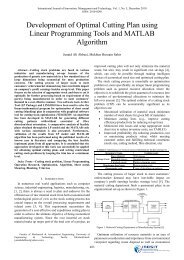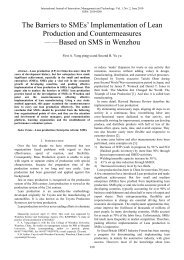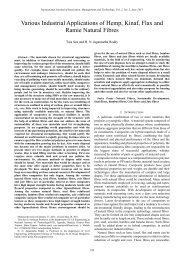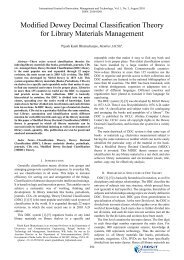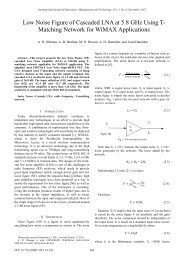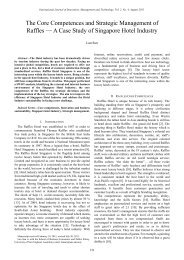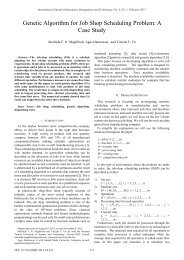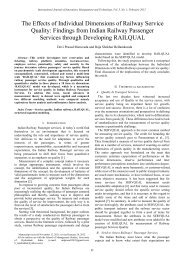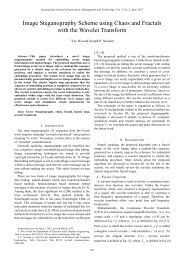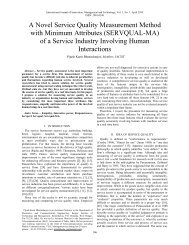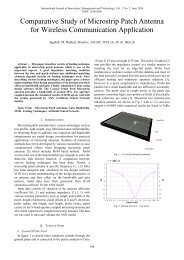Teaching and Evaluation of Business Communication ... - ijimt
Teaching and Evaluation of Business Communication ... - ijimt
Teaching and Evaluation of Business Communication ... - ijimt
You also want an ePaper? Increase the reach of your titles
YUMPU automatically turns print PDFs into web optimized ePapers that Google loves.
International Journal <strong>of</strong> Innovation, Management <strong>and</strong> Technology, Vol. 1, No. 4, October 2010<br />
ISSN: 2010-0248<br />
[13] Cowan, J (1998). On Becoming an Innovative University Teacher.<br />
Buckingham: Society for Research into Higher Education, RHE <strong>and</strong><br />
Open University Press.<br />
[14] Cowan, J. (1999). Assessing Reflection. Workshop presented at the<br />
Year <strong>of</strong> Assessment, The Robert Gordon University, Aberdeen.<br />
[15] Cox, Homer L. (1970). <strong>Communication</strong> testing practices: A survey <strong>of</strong><br />
selected universities. Journal <strong>of</strong> <strong>Business</strong> <strong>Communication</strong>, Volume 8,<br />
No.1, pp.13-23.<br />
[16] Crooks, Terence J. (1988). Impact <strong>of</strong> classroom evaluation practices on<br />
students. Review <strong>of</strong> Educational Research, Volume 58, No. 4, pp.<br />
438-481.<br />
[17] Donaldson, A.J.M. <strong>and</strong> Topping, K.J. (1996). Promoting Peer Assisted<br />
Learning amongst Students in Higher <strong>and</strong> Further Education. (SEDA<br />
paper 96) Birmingham: SEDA.<br />
[18] Du-Babcock, B. (2006). TEACHING BUSINESS<br />
COMMUNICATION: Past, Present, <strong>and</strong> Future. Journal <strong>of</strong> <strong>Business</strong><br />
<strong>Communication</strong>, Volume 43, No. 3, pp. 253-264.<br />
[19] Fall, R<strong>and</strong>y <strong>and</strong> Webb, Noreen M. (2000). Group discussion <strong>and</strong><br />
large-scale language arts assessment: effects on students'<br />
comprehension. American Educational Research Journal, Volume 37,<br />
No. 4, pp. 911-941.<br />
[20] Feinberg, Susan. (1979). <strong>Evaluation</strong> <strong>of</strong> business communication<br />
techniques. Journal <strong>of</strong> <strong>Business</strong> <strong>Communication</strong>, Volume 16, No. 3, pp.<br />
15-30.<br />
[21] Gibbs, G <strong>and</strong> Simpson, C. (2004-05). Conditions under which<br />
Assessment Supports Students’ Learning. Learning <strong>and</strong> <strong>Teaching</strong> in<br />
Higher Education, Issue 1.<br />
[22] Gibbs, G. (1992). Improving the Quality <strong>of</strong> Student Learning. Bristol:<br />
Technical Education Services.<br />
[23] Hagge, J. (1989). The spurious paternity <strong>of</strong> business communication<br />
principles. Journal <strong>of</strong> <strong>Business</strong> <strong>Communication</strong>, Volume 26, pp.33-55.<br />
[24] Hartley, J. (1998). Learning <strong>and</strong> studying, London: Routledge<br />
[25] Juwah, C. (2003). Using Peer Assessment to Develop Skills <strong>and</strong><br />
Capabilities. USDLA Journal, Volume 17, No.1.<br />
[26] Krapels, R. H., <strong>and</strong> Arnold, V. D. (1998). Response to Murphy’s<br />
“Re-viewing business communication.” Journal <strong>of</strong> <strong>Business</strong><br />
<strong>Communication</strong>, Volume.35, pp.149-153.<br />
[27] Locker, K. O. (1998). The role <strong>of</strong> the Association for <strong>Business</strong><br />
<strong>Communication</strong> in shaping business communication as an academic<br />
discipline. Journal <strong>of</strong> <strong>Business</strong> <strong>Communication</strong>, Volume 35, No.1,<br />
pp.14-49.<br />
[28] Lundelius,J <strong>and</strong> Poon. E. (1997). Cross-Sectioning Mock Job<br />
Interviews for Peer <strong>Evaluation</strong>. <strong>Business</strong> <strong>Communication</strong> Quarterly,<br />
Volume. 60, pp.165-170.<br />
[29] Maes, Jeanne D; Weldy, Teresa G. <strong>and</strong> Icenogle, Marjorie L. (1997). A<br />
managerial perspective: oral communication competency is most<br />
important for business students in the workplace. The Journal <strong>of</strong><br />
<strong>Business</strong> <strong>Communication</strong>, Volume 34, No.1, pp.67-81.<br />
[30] Mainkar, Avinash V. (Feb2008). A student-empowered system for<br />
measuring <strong>and</strong> weighing participation in class discussion. Journal <strong>of</strong><br />
Management Education, Volume 32 Issue 1, pp. 23-37.<br />
[31] Marton, F. <strong>and</strong> Saljo, R. (1984) Approaches to Learning. In: The<br />
Experience <strong>of</strong> Learning. Marton,F., Hounsell, D. <strong>and</strong> Entwistle, N.<br />
(Eds). Edinburgh: Scottish Academic Press.<br />
[32] Matsuno, Sumie. (2009). Self-, Peer-, <strong>and</strong> Teacher-Assessments in<br />
Japanese University EFL Writing Classrooms. Language Testing,<br />
Volume 26, No.1, pp.75-100.<br />
[33] McDowell, L. <strong>and</strong> Mowl, G. (1996) Innovative assessment - Its impact<br />
on students, 131-147 in Gibbs, G. (ed.) Improving student learning<br />
through assessment <strong>and</strong> evaluation, Oxford: The Oxford Centre for<br />
Staff Development.<br />
[34] McKenney, James L. (July 1962). An <strong>Evaluation</strong> <strong>of</strong> <strong>Business</strong> Game in<br />
an MBA Curriculum. JSTOR: The Journal <strong>of</strong> <strong>Business</strong>, Volume 35,<br />
No.3, pp. 278-286.<br />
[35] Mowl, G. (1996). Innovative Assessment, in Deliberations<br />
http://www.lgu.ac.uk/deliberations/assessment/mowl_content.html<br />
[36] Nichols, Ralph G.; Brown, James I. <strong>and</strong> Keller, Robert J. (2006).<br />
Measurement <strong>of</strong> communication skills. International Journal <strong>of</strong><br />
Listening. URL: http://www.listen.org 15, retrieved on 30 July 2009.<br />
[37] Ogunleye, James. (February 2006). A review <strong>and</strong> analysis <strong>of</strong><br />
assessment objectives <strong>of</strong> academic <strong>and</strong> vocational qualifications in<br />
English further education, with particular reference to creativity.<br />
Journal <strong>of</strong> Education <strong>and</strong> Work, Volume19, No.1, pp. 91-204.<br />
[38] Patricia <strong>and</strong> Black, Paul (2004). Redefining assessment The first ten<br />
years <strong>of</strong> assessment in education. Assessment in Education: Principles,<br />
Policy <strong>and</strong> Practice, Volume 11, No.1, pp. 7 – 26.<br />
[39] Porter, M. (1985). Competitive advantage. New York: Free Press. pp.<br />
911-941.<br />
387<br />
[40] Race, P. (1998) Practical Pointers in Peer Assessment, 113-122 in Peer<br />
Assessment in Practice, Brown, S. (ed.) (SEDA paper 102)<br />
Birmingham: SEDA.<br />
[41] Race, P. (1998). Practical Pointers on Peer-Assessment SEDA Paper<br />
102, Birmingham: SEDA Publications.<br />
[42] Ramsden, P. (1992). Learning to Teach in Higher Education. London:<br />
Routledge.<br />
[43] Rogers, P. S. (1996). Disciplinary distinction or responsibility.<br />
Management <strong>Communication</strong> Quarterly, Volume 10, No.1,<br />
pp.112-123.<br />
[44] Thorpe, Mary. (2000). Encouraging students to reflect as part <strong>of</strong> the<br />
assignment process: Student responses <strong>and</strong> tutor feedback. Active<br />
Learning in Higher Education, Volume 1, No. 1, pp. 79-92.<br />
[45] Topping, K. (1996). Effective Peer Tutoring in Further <strong>and</strong> Higher<br />
Education, (SEDA Paper 95) Birmingham: SEDA.<br />
[46] Topping, K. (1998). Peer assessment between students in colleges <strong>and</strong><br />
universities. Review <strong>of</strong> Educational Research, Volume 68, pp.<br />
249-276.<br />
[47] Zariski, A. (1996). Student peer assessment in tertiary education:<br />
Promise, perils <strong>and</strong> practice. In Abbott, J. <strong>and</strong> Willcoxson.



